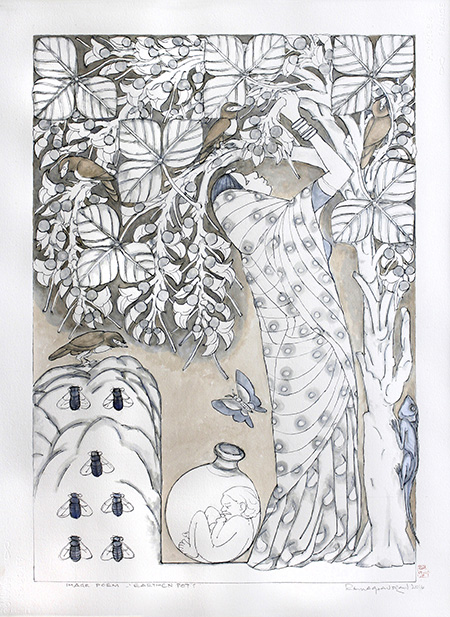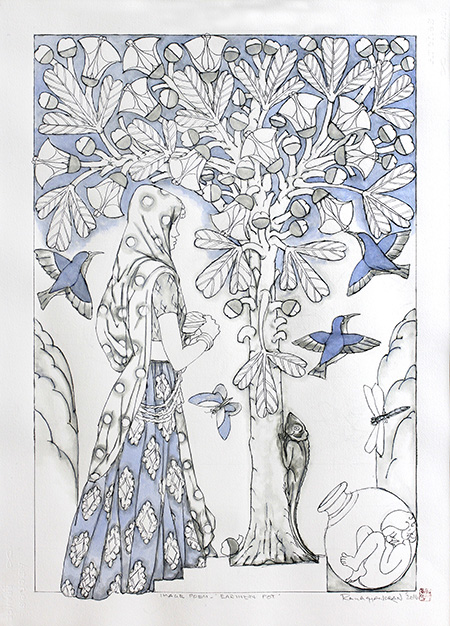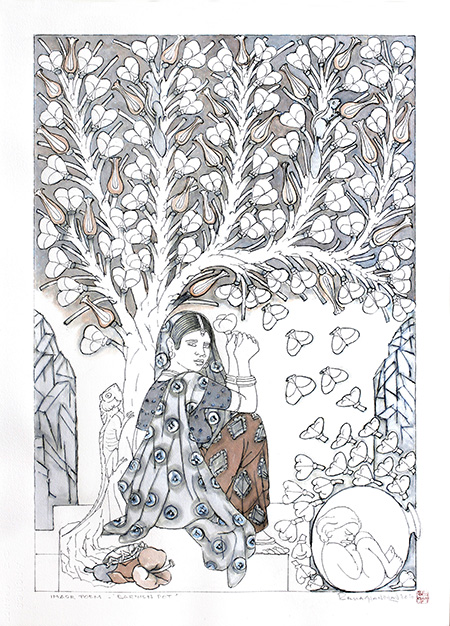A sari-clad Rajasthani woman picks petals, for a pooja perhaps, from a tree, surrounded by winged creatures and a watchful monitor lizard. But where the eye lingers longest is at the round-bottomed pot that sits at her feet, in which curled up in the foetal position is a ghostly outline of the 81-year-old artist.
This image on the invitation card of the Vadehra Art Gallery is a befitting introduction to the show of maestro Achuthan Ramachandran.
![2016-04-29-1461922674-6802107-01.jpg]()
The author, artist, professor from Shantiniketan and Jamia Millia Institute of Fine Arts tells tales that are woven deeply in the tapestry of time. Bengali poetry flows effortlessly from the lips of this polyglot (he's fluent in English, Malayalam and Bengali) and he quotes liberally from both Rabindranath and Abanindranath Tagore. He has celebrated the age-old technique of murals for 60 years and silenced his critics.
"My works are self-explanatory, I don't like to explain my work. Once we explain, nothing is left for the viewer to rejoice at," he says in his grainy baritone.
"This show is a series of watercolours that read like poems. In each work you will see a tree, a woman and a pot. And yes, in each pot you will find my self-portrait. Drawing is an integral part of my daily ritual. It's just like a musician having to string the taanpura every day to do his riyaaz. I need to draw. It is my elixir."
![2016-04-29-1461922701-1811612-03.jpg]()
An 81-year-old artist who lives in an earthen pot, and who loves exhibiting the male gaze? He smiles, "Oh yes, I am an embodiment of the MCP (male chauvinist pig), I suffer from an occasional bout of this disease called the male gaze. This may be a hereditary one of Kerala origin coming down from Raja Ravi Varma to myself or one acquired under the tutelage of my teacher, Ram Kinkar. An overall survey of the works of art in our own tradition also reveals the emphasis on the subtleties of the woman's body."
He continues: "As an artist, I am the proverbial gazer, I have always gazed at the life of the people of Rajasthan. Their humble lifestyles and their dependence on the foliage have formed my fascination. While studying the trees I also grew to love the little insects, the animals and birds that flocked towards these forests."
In this small show of ethereal, limpidly lithe toned watercolours, you see ecological focus--from the abundantly flowing leafed and flowery trees to the rhythms of fauna amid the human form, to the mythopoeic earthen pot with its fables. We see humble Rajasthani belles, their heads in ghunghats, who are happy in their own solitude.
A quiet assurance comes out in Ramachandran's new series, sans his favourite lotus ponds, a cultural culmination of a soft, lyrical engagement with nature in which the colours of the forests have been bleached and softened with the Arctic sun that he weathered while living in America for the past few months.
![2016-04-29-1461922744-9845600-04.jpg]()
In 1997, during an evening conversation at his home, Ramachandran told me: "I sat near the lotus pond and watched the changing hues of colour on large leaves, the tall stalks holding flowers and buds, swaying in the breeze along with golden reeds, like a graceful tribal dance. After three days of observation, the changing moods of this magnificent lotus pond became a lotus pond of my mind: Mansarovar, providing a Gita Govinda setting, for the god of little things to enact a playful activity--a Leela of insects, butterflies and dragonflies, swinging between the conscious and the subconscious."
In this small but haunting show at Vadehra, there is no lotus pond ,but there is the tradition of living ensconced in the fine details of a tree, a youthful sari-clad woman and an 81-year-old man who is happy to dwell within an earthen pot.
Achuthan Ramachandran's exhibition "Earthen Pot" will show at Vadehra Art Gallery, New Delhi, until 21 May.
Artist's bio: He left his native Kerala for Shantiniketan in 1957. There he groomed under his chosen master, the inspiring but bohemian genius Ram Kinkar Baij. Shantiniketan, with its galaxy of art teachers and artists like Nandalal Bose and Benode Behari Mukherjee gave Ramachandran his love for the language of tradition. Today, he is a muralist, sculptor, author of 50 children's books, a scholar on Indian art and one of India's masters in both oils and watercolours.
![]() Like Us On Facebook |
Like Us On Facebook |
![]() Follow Us On Twitter |
Follow Us On Twitter |
![]() Contact HuffPost India
Contact HuffPost India
Also see on HuffPost:
This image on the invitation card of the Vadehra Art Gallery is a befitting introduction to the show of maestro Achuthan Ramachandran.

The author, artist, professor from Shantiniketan and Jamia Millia Institute of Fine Arts tells tales that are woven deeply in the tapestry of time. Bengali poetry flows effortlessly from the lips of this polyglot (he's fluent in English, Malayalam and Bengali) and he quotes liberally from both Rabindranath and Abanindranath Tagore. He has celebrated the age-old technique of murals for 60 years and silenced his critics.
This show is a series of watercolours that read like poems. In each work you will see a tree, a woman and a pot. And yes, in each pot you will find my self-portrait.
"My works are self-explanatory, I don't like to explain my work. Once we explain, nothing is left for the viewer to rejoice at," he says in his grainy baritone.
"This show is a series of watercolours that read like poems. In each work you will see a tree, a woman and a pot. And yes, in each pot you will find my self-portrait. Drawing is an integral part of my daily ritual. It's just like a musician having to string the taanpura every day to do his riyaaz. I need to draw. It is my elixir."

An 81-year-old artist who lives in an earthen pot, and who loves exhibiting the male gaze? He smiles, "Oh yes, I am an embodiment of the MCP (male chauvinist pig), I suffer from an occasional bout of this disease called the male gaze. This may be a hereditary one of Kerala origin coming down from Raja Ravi Varma to myself or one acquired under the tutelage of my teacher, Ram Kinkar. An overall survey of the works of art in our own tradition also reveals the emphasis on the subtleties of the woman's body."
He continues: "As an artist, I am the proverbial gazer, I have always gazed at the life of the people of Rajasthan. Their humble lifestyles and their dependence on the foliage have formed my fascination. While studying the trees I also grew to love the little insects, the animals and birds that flocked towards these forests."
I am an embodiment of the MCP (male chauvinist pig), I suffer from an occasional bout of this disease called the male gaze.
In this small show of ethereal, limpidly lithe toned watercolours, you see ecological focus--from the abundantly flowing leafed and flowery trees to the rhythms of fauna amid the human form, to the mythopoeic earthen pot with its fables. We see humble Rajasthani belles, their heads in ghunghats, who are happy in their own solitude.
A quiet assurance comes out in Ramachandran's new series, sans his favourite lotus ponds, a cultural culmination of a soft, lyrical engagement with nature in which the colours of the forests have been bleached and softened with the Arctic sun that he weathered while living in America for the past few months.

In 1997, during an evening conversation at his home, Ramachandran told me: "I sat near the lotus pond and watched the changing hues of colour on large leaves, the tall stalks holding flowers and buds, swaying in the breeze along with golden reeds, like a graceful tribal dance. After three days of observation, the changing moods of this magnificent lotus pond became a lotus pond of my mind: Mansarovar, providing a Gita Govinda setting, for the god of little things to enact a playful activity--a Leela of insects, butterflies and dragonflies, swinging between the conscious and the subconscious."
In this small but haunting show at Vadehra, there is no lotus pond ,but there is the tradition of living ensconced in the fine details of a tree, a youthful sari-clad woman and an 81-year-old man who is happy to dwell within an earthen pot.
Achuthan Ramachandran's exhibition "Earthen Pot" will show at Vadehra Art Gallery, New Delhi, until 21 May.
Artist's bio: He left his native Kerala for Shantiniketan in 1957. There he groomed under his chosen master, the inspiring but bohemian genius Ram Kinkar Baij. Shantiniketan, with its galaxy of art teachers and artists like Nandalal Bose and Benode Behari Mukherjee gave Ramachandran his love for the language of tradition. Today, he is a muralist, sculptor, author of 50 children's books, a scholar on Indian art and one of India's masters in both oils and watercolours.
 Like Us On Facebook |
Like Us On Facebook |  Follow Us On Twitter |
Follow Us On Twitter | Also see on HuffPost: